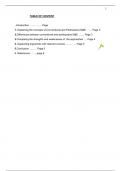2
TABLE OF CONTENT
. Introduction …………… Page
1. Explaining the concepts of Conventional and Participatory M&E ……. Page 3
2.Differences between conventional and participatory M&E ……. Page 3
3.Comparing the strengths and weaknesses of the approaches …. Page 4
4. Supporting arguments with relevant sources …………. Page 5
5.Conclusion ……… Page 5
6. References ……. page 6
, 3
INTRODUCTION
Monitoring, also known as formative assessment, tracks development during a
project's execution. Evaluation, which is also known as summative evaluation,
renders conclusions regarding the effects and results of a project, especially since
they matter to stakeholders. The essay aims at exploring the concepts of
participatory and conventional M&E, providing the differences between conventional
and participatory m&e and comparing the strengths and weaknesses of the two as
well as drawing arguments with relevant sources to support my claims.
1. Explain the concept of Conventional and Participatory M&E.
The term participatory dates to the 1990s but has grown to relate to contemporary
thought and a new paradigm that has moulded methods of operation different from
the conventional top-down method . Participatory M&E is about engaging different
stakeholders within monitoring and evaluation. Participatory M&E is defined by the
World Bank (2010a) as the process by which stakeholders at different levels,
programs, or policies share or evaluate a specific project, program, or policy, share
control over the content, the process, and the outcomes of the monitoring and
evaluation activity, and engage in taking or identifying corrective actions. Usually,
when someone uses the term target individuals, groups, or communities," they mean
participation. Participatory m&e belongs to a larger category of Participatory
methods.
According to the World Bank (2010), it emphasizes the primary stakeholders' active
engagement. Philip et al. (2008) state that participatory monitoring and evaluation
guarantees that the execution of the various projects included in the action plan or
smaller, standalone initiatives results in the desired outcomes. Participatory
monitoring and evaluation must be conducted before the project is put into action,
just like all other monitoring and evaluation components. The end users of project
goods and services, including both men and women at the community level,
intermediary organizations, including NGOS, the private sector, businesses involved
in the project, and government staff at all levels are the stakeholder groups typically
involved in a participatory m&e activity (Rietbergen McCracken 1998).
Conventional M&E implies something banal, ordinary, or of traditional design. The
basic objective of conventional M&E is to maximize system or project effectiveness.
Using scientific objectivity to make decisions that will increase the project's
effectiveness is the process' main goal. It largely relies on academic research and
pre-set indicators to determine results . Conventional M&E, also known as top-down
or directive monitoring and evaluation, is typically carried out toward the end of a
program or project, leaving little room for improvement during early and mid-term
implementation ( Vernooy, Qiu & Jianchu 2006:401 ).
2. THE DIFFERENCE BETWEEN CONVENTIONAL AND PARTICIPATORY M&E.
Participatory m&e considers the needs of the impoverished and the oppressed(
Dube , Mthimkulu & Zuma 2019:76). Involving the community ensures that the
community grows. Prioritizing community engagement in development projects.
Allowing people to freely participate in decision-making processes (Dube et al




